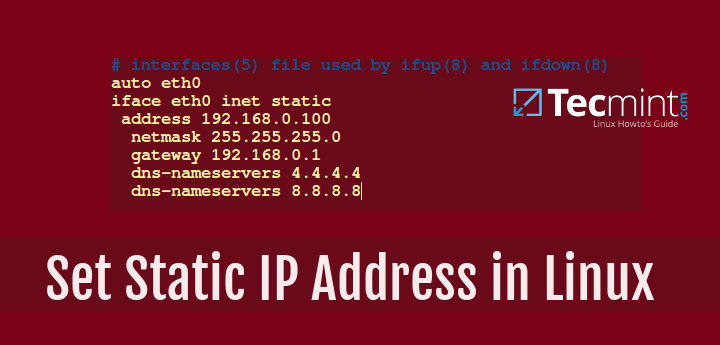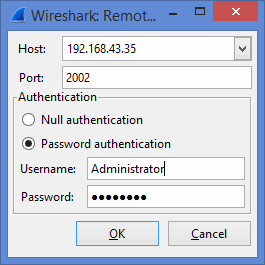Stastic Ip Address On Linux Using Gui Intefaces


- To configure a static IP address using the new NetPlan tool on Ubuntu server, the file should look similar to the content below For example you might find a default netplan configuration file in the /etc/netplan directory called 50-cloud-init.yaml with a following content using the networkd deamon to configure your network interface via DHCP.
- An IP address is an address used to uniquely identify a device on an IP network. For two computers to communicate with each other and share data, they need to have IP addresses set to their network interface. An IP address can be assigned manually (static IP Address) or via DHCP.
In this guide, I'll show you how to set a static IP in your Debian desktop or server. Address it via a fixed IP address, assigning it a static IP is your best choice. Same interface, or perhaps add an IP alias to the same interface, use eth0:0, eth0:1, etc. If your system is already installed and you don't have a graphical desktop.
Find Ip Address On Linux
Hace 12 días
why use ethic when your ifconfig showed wlan an eth0 , this kind of random assignment is what causes confusion when we are trying to learn and copy. Just a heads up. You should have explained why not using ethic, or wlan, are they different, do we have a choice, can it be random ? I dunno
Hace 4 días
@Brad Brockmeier thanks brad I meant eth0. Sorry for my grumpy message. Networking is killing me.
Hace 12 días
What do you mean by ethic? Do you mean eth1? I will have to rewatch my video, as it has been some time since I recorded it. However, I probably had my network configuration exactly how I wanted it, and didn't want to mess it up for the video.
Hace 3 años
Can some1 explain to me y my eth0 inet addr is 10.0.02.15 instead of like 192.168.02.108 Every video I see their inet addr starts with 192 why doesn't mine
Hace 3 años
+VII Because they all uses their pc for home uses and they dont want 10^24-2 addresses provided class a 10.0.0.0/8 private ip range and they are happy with 192.168.*.* class c private ip range which provides 254 addresses and are much enough. but as your personal choice you can use ip starting with 10.*.*.* address
Hace 3 años
@VII The reason your IP address is 10.0.2.# instead of 192.168.2.# is because of your network. Whoever set up your equipment put your network address as the former.
Hace 4 años
@Ronny OnBass Can you provide some information as to what your goal was, and what didn't work?
Hace 4 años
That is not an IP Address issue, that is a browser cookie issue.
Hace 6 años
What happened when you tried the above commands?
Hace 6 años
btw, not sure if you've encountered this problem, but with both, debian-based and red hat-based distros, i've had NetworkManager screw up these configurations. NetworkManager seems to override these settings and do it's own thing. if you're going to do it this way, i recommend stopping the NM daemon, or removing it altogether. (even though in RH-based distros, you can add an option in the ifcfg-eth0 file that says 'NM_CONTROLLED=no' and you should be fine with that)
Hace 6 años
well, the '/etc/resolv.conf' and '/etc/hosts' file are the same, but in red hat based distros, instead of '/etc/network/interfaces', the info for the network interfaces is stored in '/etc/sysconfig/network-scripts/ifcfg-eth0' (assuming it's for the eth0 interface). the hostname is stored in the '/etc/sysconfig/network' file also the syntax is slightly different. for example, instead of 'address 192.168.x.x' you write 'IPADDR=192.168.x.x' not a huge change, but it's noteworthy.
Hace 6 años
I would have, if I had known that. I've mainly stuck to Ubuntu, but I've experimented with Fedora, Open SuSE, Damn Small Linux, IPCop, and a couple others I can't remember. How does it differ though? Is it just a different directory, completely different syntax structure, both?
Hace 6 años
you should've specified that this is for debian-based linux distros. redhat based distros are totally different as far as setting up static ip's..
Hace 7 años
Can you copy & paste the whole error message?
Hace 7 años
@alnuwan Not having used Redhat, I'm unfamiliar with the directories, but I found this guide that is hopefully still relevant. Otherwise, you can use the ifconfig command to statically set it.
Hace 7 años
I use redhat as a guest in windows 7 host using virtualbox. I do not see the /etc/network/interfaces file. help?
Hace 7 años
@barnbarn122 DynDNS makes sure that any attempt at finding your domain, points to your network, even though you have a changing network address.
Hace 7 años
@FuzzyGhost Wow thats confusing...I know how to port forward (port on MC is 25565 and i have a d-link router) and my ISP is xfinity/comcast. So what does DynDNS do?
Hace 7 años
@barnbarn122 Either contacting your ISP to setup a static IP address, or using DynDNS (or something like it), you would then set up port forwarding on your modem/router (to the port that MineCraft uses for communications). I wish I could give you exact directions, but this will vary depending on the company/equipment/software.
Hace 7 años
@FuzzyGhost lol i'm not into networking that much but exactly how would i setup a server with my public ip and port so anyone could get on it?
Hace 7 años
@barnbarn122 I've not used Hamachi, but I've not had a need for a Virtual Private Network. Are you sure you need that for a Minecraft server? Seems like you would just need a public static IP address, which would cost extra with your ISP, or using a Dynamic DNS client.
Hace 7 años
@FuzzyGhost Well thanks but I'm only trying to make a public minecraft server for a few friends and hamachi wont work on Wine(Linux mint 11) Any help?
Hace 7 años
@barnbarn122 The principle and method are the same, just swap out the name of the networking device. Instead of using eth0, us whatever ifconfig pops up for your wireless networking device (for example, wlan0).
Hace 7 años
dammit why couldnt it be on a wireless card >:( not ethernet :P